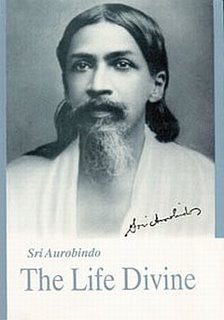 |
The Divine Soul
The Divine Consciousness has been perceived by seers throughout the ages in any of the three poises of the Individual, Universal (cosmic) or Transcendent. In many religious traditions, the Transcendent is what is revered as God while the Universal and the Individual being its secondary derivatives or creations. However Sri Aurobindo views the Individual, the Universal and the Transcendent as three equally significant poises of the same Reality. It naturally follows that the simultaneous realization of Reality at the three poises must need a unique plane of Consciousness to be perceived and effectuated for this is not possible in our ordinary consciousness. The simultaneous realization is also not possible if one enters the Universal Consciousness or Transcendental Consciousness by surpassing the Individual. For example, a common technique to perceive the Universal Consciousness is by expanding oneself from the limits of the individuality. In the process, the Individual loses itself in the unending vastness of the cosmic ocean. This is a valid spiritual experience as one surpasses the ego to disappear into cosmicity. However this cosmic experience does not allow the Universal and the Individual to be poised with equal significance for in the end, the Individual merges with the cosmicity. In other words, the Individual loses its significance in the vastness of the Universal Consciousness. In Sri Aurobindo’s scheme of things, the experience of the ego-surpassing, fourth dimensional soul-principle or Psychic Being which is the evolutionary poise of the Jivatman (the Individual Self) allows the flowering of the Inner Being (or subliminal personality) that stands behind the Outer Being (surface personality). The Inner Being is connected with the Universal Consciousness. Forces and influences from the Cosmic Consciousness enter the Inner Being and from there trickle into the Outer Being. If the Psychic Being has been worked upon to surpass the ego, the individual runs less risk of being devoured by negative forces from the Cosmic Ignorance and in turn becomes receptive to the positive universal forces, a little of which is enough for our creative out flowering. This model allows the simultaneous realization of the Individual Self and the Cosmic Self with equal significance and without allowing one to be subjugated to the other.
|
|
To have the simultaneous realization of the Individual, Universal and Transcendent is more difficult than the simultaneous realization of the individual and Universal. This is because the Transcendent is beyond both the Individual and the Universal. A usual experience of the Transcendent annuls both individuality and universality rendering the Absolute as a Reality to be beyond everything. Sri Aurobindo postulated that to have a simultaneous realization of the Reality in the three poises, one has to have access to the mode of the Self in the creative matrix of the Supramental Consciousness which he termed as the Divine Soul (translated by Sri Anirvan as divvya Purusha). In this poise, the Divine Soul can be experienced as a ‘self-form’ of the Transcendent. At this level, the Divine Soul relates the Transcendent with the Universal and Individual not in terms of differentiation and divisibility but in terms of ‘extension’ of consciousness. ‘The divine soul will be aware of all variation of being, consciousness, will and delight as the outflowing, the extension, the diffusion of that self-concentrated Unity developing itself, not into difference and division, but into another, an extended form of infinite oneness. It will itself always be concentrated in oneness in the essence of its being, always manifested in variation in the extension of its being. All that takes form in itself will be the manifested potentialities of the One, the Word or Name vibrating out of the nameless Silence, the Form realizing the formless essence, the active Will or Power proceeding out of the tranquil Force, the ray of self-cognition gleaming out from the sun of timeless self-awareness, the wave of becoming rising up into shape of self-conscious existence out of the eternally self-conscious Being, the joy and love welling for ever out of the eternal still Delight. It will be the Absolute biune in its self-unfolding, and each relativity in it will be absolute to itself because aware of itself as the Absolute manifested but without that ignorance which excludes other relativities as alien to its being or less complete than itself’(The Life Divine, pg 166-167).
In our ordinary cognitive experience knowledge winds its way by continually synthesizing discordances and relativities. It is not ordinarily possible to have the realization of the multiplicity as the Transcendent in its extended oneness, neither is it possible to view Delight (which we usually perceive as dynamic) to be eternally ‘still’ in our ordinary consciousness. Such experiences of an entirely different dimension need a different cognitive field. In fact the Supramental consciousness alone can uphold such an integral cognitive matrix that surpasses even a global cognitive field. The Spirit in its mode of the Divine Soul at the Supramental plane can alone simultaneously perceive the Transcendent, Universal and Individual in an Integral cognitive matrix.
Date of Update:
21-Apr-16
- By Dr. Soumitra Basu
|

